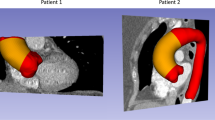Abstract
It was shown in a previous study by Stålhand et al. (2004) that both material and residual strain parameters for an artery can be identified noninvasively from an in vivo clinical pressure–diameter measurement. The only constraints placed on the model parameters in this previous study was a set of simple box constraints. More advanced constraints can also be utilized, however. These constraints restrict the model parameters implicitly by demanding the state of the artery to behave in a specified way. It has been observed in vitro that the axial force is nearly invariant to the pressure at the physiological operation point. In this paper, we study the possibility to include this behaviour as a constraint in the parameter optimization. The method is tested on an in vivo obtained pressure–diameter cycle for a 24-year-old human. Presented results show that the constrained parameter identification procedure proposed here can be used to obtain good results, and we believe that it may be applied to account for other observed behaviours as well.





Similar content being viewed by others
References
Cox RH (1978) Regional variation of serial elasticity in canine arterial smooth muscles. Am J Physiol 234:H542–H551
Dobrin PB (1983) Vascular mechanics. In: Shepherd J, Abbound F (eds) Handbook of physiology. Part I. Peripheral circulation and organ blood flow. Williams and Wilkins, Baltimore, pp 65–102
Fung YC, Fronek K, Patitucci P (1979) Pseudoelasticity of arteries and the choice of its mathematical expression. Am J Physiol 273:H620–H631
Holzapfel GA (2000a) Nonlinear solid mechanics. A continuum approach for engineering. Wiley, Chichester
Holzapfel GA, Gasser TC, Ogden RW (2000b) A new constitutive framework for arterial wall mechanics and a comparative study of material models. J Elasticity 61:1–48
Humphrey JD (2002) Cardiovascular solid mechanics. Springer, Berlin Heidelberg New York
Ogden RW (1997) Non-linear elastic deformations. Dover Publication, New York
Ogden RW, Schulze-Bauer CAJ (2000) Phenomenological and structural aspects of the mechanical response of arteries. In: Casey J, Bao G (eds) Mechanics in biology AMD-vol 242, BED-vol 46, New York, pp 125–140
Rachev A, Hayashi K (1999) Theoretical study of the effects of vascular smooth muscle contraction on strain and stress distribution in arteries. Ann Biomed Eng 27:459–468
Schulze-Bauer CAJ, Holzapfel GA (2003) Determination of constitutive equations for human arteries from clinical data. J Biomechanics 36:165–169 DOI:10.1016/S0021-9290(02)00367-6
Schulze-Bauer CAJ, Mörth C, Holzapfel GA (2003) Passive biaxial mechanical response of aged human iliac arteries. J Biomech Eng 395–406 DOI 10.1115/1.1574331
Sonneson B, Länne T, Vernersson E, Hansen F (1994) Sex difference in the mechanical properties of the abdominal aorta in human beings. J Vasc Surg 20:959–969
Sonneson B, Vernersson E, Hansen F, Länne T (1997) Influence of sympathetic stimulation of the mechanical properties of the aorta in humans. Acta Physiol Scand 159:139–145
Stålhand J, Klarbring A, Karlsson M (2004) Towards in vivo aorta material identification and stress estimation. Biomechan Model Mechanobiol 2:169–186 DOI 10.1007/S10237-003-0038-2
Takamizawa K, Hayashi K (1987) Strain energy density function and uniform strain hypothesis for arterial mechanics. J Biomech 20:7–17
Takamizawa K, Matsuda T (1990) Kinematics for bodies undergoing residual stress and its application to the left ventricle. ASME J Appl Mech 57:321–329
Vaishnav RN, Vossoughi J (1983) Estimation of residual strains in aortic segments. In: CW Hall (ed) Biomedical engineering II, recent developments. Pergamon Press, New York, pp 330–333
Weizsäcker HW, Kampp TD (1990) Passive elastic properties of the rat aorta. Biomed Tech 35:224–234
Acknowledgements
The authors wish to thank Professor Matts Karlsson at the Department of Biomedical Engineering and Professor Toste Länne at the Department for Medicine and Care, both at Linköping University.
Author information
Authors and Affiliations
Corresponding author
Rights and permissions
About this article
Cite this article
Stålhand, J., Klarbring, A. Aorta in vivo parameter identification using an axial force constraint. Biomech Model Mechanobiol 3, 191–199 (2005). https://doi.org/10.1007/s10237-004-0057-4
Received:
Accepted:
Published:
Issue Date:
DOI: https://doi.org/10.1007/s10237-004-0057-4




